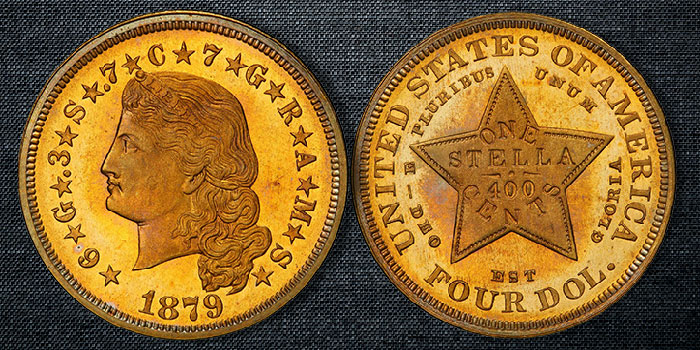
By Stack’s Bowers ……
The Pogue Specimen Proof-66 Cameo (PCGS) CAC – Among the Finest Known
1879 Four-Dollar Gold Stella. Flowing Hair. Judd-1635, Pollock-1833. Rarity-3. Gold. Reeded Edge. Proof-66 Cameo (PCGS). CAC.
Over the years, the Stella has achieved near-legendary status among numismatists.
Though classed as a pattern, the Stellas have long been included as key to a type collection of United States gold, thanks in no small part to inclusion in the Guide Book for generations. The inclusion of any Stella in any condition has long been considered a great numismatic achievement, and most examples are found in grades of Proof-65 and lower. The beautiful Proof-66 Cameo (PCGS) CAC offered here is among the very finest known and will surely be a crowning jewel in the cabinet or PCGS Registry Set of its next owner.
The blended golden-olive and orange-apricot patina provides outstanding visual appeal, while the centers have blushes of equally attractive pinkish-rose iridescence. Reflective fields support frosty design elements, with the interplay between these two features resulting in the coveted Cameo designation from PCGS. Here is a sharply struck, beautifully preserved example of this classic 19th-century gold type.
How the Stella Four-Dollar Gold Coin Came to Be
The story of the rare and historic four-dollar gold Stellas of 1879 and 1880 begins with the desire in certain government circles to create an international coinage system that would be readily recognized and accepted throughout the world.
Although it had surfaced earlier, this idea gained its greatest momentum in 1879 through the efforts of John A. Kasson, the United States’ minister plenipotentiary to the Austro-Hungarian Empire and a former chairman of the Congressional Committee on Coinage, Weights and Measures. Kasson urged the federal government to consider the creation of a four-dollar gold coin as the basis for a new international monetary system.
Why a four-gold gold coin, one might ask, especially considering the widely accepted five-dollar half eagles and twenty-dollar double eagles already in international use? In Kasson’s opinion, a four-dollar gold coin struck by the United States Mint would more closely approximate in value the more widely used and accepted gold coins of several European countries, including Austria’s 8 florins, the Dutch 8 florins, France’s 20 francs, Italy’s 20 lire, and Spain’s 20 pesetas.
Two obverse designs were prepared, each featuring a different representation of Liberty: the Flowing Hair design by Charles E. Barber, as here, and the Coiled Hair design by George T. Morgan. Surrounding Liberty’s bust is the legend *6*G*.3*S*.7*C*7*G*R*A*M*S* to indicate the intended composition of the new “metric” alloy. Both varieties are paired with the same reverse design featuring the prominent large five-pointed star from which the coin earned its name and the denomination expressed three ways: ONE STELLA, 400 CENTS, and FOUR DOL. Both designs were produced bearing the dates 1879 and 1880 for a total of four basic varieties of Stella.
While the primary legislative consideration was focused on the $4 gold piece, $20 “Quintuple Stella” patterns were also prepared along with metric silver and goloid dollars. Additional patterns of the $4 coin were also prepared in copper, aluminum, and white metal in unknown but certainly small quantities.
Of the two obverse designs, Barber’s Flowing Hair was selected to be presented to Congress for review and approval. Estimates vary as to how many were coined for the three-piece Proof pattern sets, ranging from 10 up to 25 pieces. The sets were shown to Congressional leaders who, alongside other government officials, took an immediate liking to the unusual coins and requested that the Mint strike more.
For all the attention surrounding the coin in the halls of Congress, the Stella was not able to attract enough support for full-scale production as there was no obvious use for it domestically. The proposal died on the vine and the Stella entered into numismatic lore. Its popularity is such that the denomination has been ranked 28th in the 2005 edition of the influential book 100 Greatest U.S. Coins by Jeff Garrett and Ron Guth.
PCGS# 88057. NGC ID: 28AZ.
PCGS Population: 14; 9 finer in this category (Proof-67+ Cameo finest).
Ex our (American Numismatic Rarities’) Allison Park Collection sale, August 2004, lot 983; our sale of the D. Brent Pogue Collection, Part VII, March 2020, lot 7331.
* * *
NGC Photo Vision Images Now Available at StacksBowers.com
Did you know Stack’s Bowers Galleries has teamed up with NGC to feature NGC Photo Vision images on the Stack’s Bowers website alongside our own award-winning photographs? NGC Photo Vision images are now available on all lot descriptions (for coins that have them) in our June 2020 Auction featuring the Francesca Collection of United States Gold Coins and all auctions moving forward at StacksBowers.com.
Stack’s Bowers Galleries is proud to offer all the information you need to bid with confidence on items in our auctions. Experience our award-winning website and online auction catalogs today at StacksBowers.com. There you can view our detailed descriptions and high-resolution images as well as access population data and price guides including Previous Prices Realized. Make sure you create a free account and log in to take advantage of these features.




